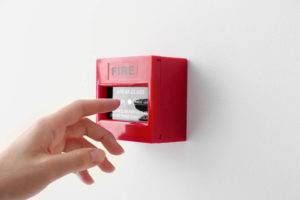Fire safety is a key part of protecting lives and property, whether at home, work, or school. Knowing how to prevent fires and respond in an emergency can make all the difference. In this guide, we’ll cover important topics like fire safety training, fire alarms, safety checklists, common causes of fires, and the different types of fire extinguishers.
Fire Safety Training
Fire safety training teaches people how to recognise risks, act in emergencies, and prevent fires in the first place. It is especially important in workplaces, schools, and shared residential buildings, where large groups of people need to act quickly and safely during an evacuation.
Training typically includes instructions on spotting potential fire hazards, understanding evacuation procedures, and using fire extinguishers properly. Many organisations also include regular fire drills to help people practice their response and get familiar with escape routes. By making fire safety training a priority, workplaces and other establishments can reduce the chances of accidents and improve outcomes during emergencies.
Fire Safety Checklist
Staying on top of fire safety is easier with a regular checklist to ensure that everything is in order. A typical review should cover items like checking that fire alarms are working, escape routes are free from obstructions, and fire extinguishers are in place and in good condition. Emergency lighting, where used, should also be inspected to confirm it is operational.
By keeping a checklist handy and reviewing it at regular intervals, you can reduce risks and improve readiness in case of an emergency. While it may seem simple, these small checks can play a big part in protecting people and property.
Common Causes Of Fires
Understanding the common causes of fires is key to preventing them. Fires often start because of human error, faulty equipment, or a lack of awareness about risks. In workplaces and other environments, some of the most common causes include:
Electrical Issues
Faulty wiring, overloaded circuits, or damaged equipment can lead to sparks and fires. Regular electrical inspections and proper maintenance are essential.
Cooking
Kitchens are a frequent source of fires, especially when left unattended. Cooking oils and fats are highly flammable, making it important to stay vigilant and have the correct extinguisher on hand.

Flammable Materials
Items like paper, chemicals, and cleaning supplies can ignite easily if stored or handled improperly. Keep these materials away from heat sources and store them in designated areas.
Smoking
Careless disposal of cigarettes is another leading cause of fires, particularly in areas where flammable materials are present. Designated smoking areas and proper disposal bins can reduce this risk.
Heating Equipment
Portable heaters and boilers can cause fires if placed too close to flammable items or left unattended. Always follow safety guidelines and inspect heating devices regularly.
Proper Use & Maintenance Of Fire Alarms
Fire alarms play a vital role in providing early warnings during a fire, giving everyone the time they need to leave the building safely. To ensure they work when needed, it’s important to maintain them properly and understand how they operate.
Fire alarms should be tested regularly—ideally every week—to confirm they are functioning correctly. Dust and debris should be cleaned away periodically, as this can interfere with their ability to detect smoke. Batteries should be replaced at least once a year or whenever the alarm starts to emit a low-battery warning beep. In workplaces and larger buildings, professional inspections are also necessary to meet safety regulations and ensure the system is in good condition.
In addition to maintenance, it’s important that everyone in a building knows the sound of the fire alarm and what to do when it goes off. Clear guidance and regular reminders can help avoid confusion during an emergency.
Types Of Fire Extinguishers
Fire extinguishers are essential tools for dealing with small fires, but it’s important to use the correct type for the situation. Here’s a quick guide to the main types of fire extinguishers and their uses:
Water Extinguishers: Effective for fires involving wood, paper, or textiles. They should not be used on electrical fires.
Foam Extinguishers: Suitable for fires caused by flammable liquids like petrol or paint.
CO2 Extinguishers: Designed for electrical fires and fires caused by flammable liquids.
Power Extinguishers: Versatile and can be used on gas, electrical, and liquid fires. However, they can create a mess, making them less ideal for indoor use.
Wet Chemical Extinguishers: Best for kitchen fires involving cooking oils or fats.

Understanding the purpose of each type of extinguisher is crucial. Fire safety training often includes demonstrations on how to use extinguishers properly, which can help build confidence in dealing with small fires.
For Fire Safety Training & Equipment, Contact City Fire Protection
Fire safety is a shared responsibility, and taking simple steps like maintaining fire alarms, following a safety checklist, and understanding how to use fire extinguishers can make a big difference in keeping people and property safe. For professional help, contact City Fire Protection. They offer fire safety training, fire alarm maintenance, and a range of other services designed to help you stay prepared.








